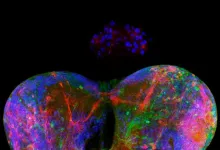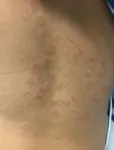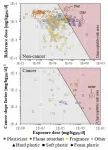(Press-News.org) With the onset of the COVID-19 pandemic, telemedicine has become a new norm for many routine and non-emergency medical needs. But there are lessons to be learned from telemedicine's use - or lack thereof - prior to the pandemic, and a new study from a UConn School of Social Work researcher offers insight for policymakers, administrators, and public health officials when considering the implementation of new services.
A qualitative researcher, lead author and licensed clinical social worker Kelsi Carolan was brought into the study - which was conducted in 2017 and 2018 and was recently published in the Journal of Medical Internet Research - to examine the adoption of a telemedicine program in a California independent senior living community.
"Initially, the study was purely looking at stats, seeing what the effects of this intervention would be, if any, on the unnecessary use of emergency transport - residents being transferred to the emergency department," Carolan says. "What my co-authors were seeing in the numbers was that it wasn't having much of an effect. The intervention didn't seem to be working."
Despite the fact that the program was being offered at no cost to residents, and despite a push from the community's administration to utilize the program for cases that were not medically urgent, telemedicine wasn't actually reducing the number of emergency room visits amongst residents in the community. The intervention uptake was low, and the researchers wanted to better understand why.
Carolan and her co-authors conducted separate focus groups with frontline, emergency-trained staff members and with residents from the community. The residents included both individuals who had previously used the telemedicine option as well as those who had not. Overall, the residents expressed a desire to avoid emergency room visits as much as possible - they disliked the long wait times, financial costs, and potential health risks of visiting the emergency room.
Some residents said the telemedicine option had helped avoid an unnecessary trip, while another said that their telemedicine experience actually reinforced the need to go to the emergency room despite the resident's initial hesitancy - an unexpected benefit that helped diagnose a serious heart condition and ultimately led to important treatment.
The perceptions and experiences of the residents, however, were often in direct contradiction to the opinions of the community's frontline staff, who reported in their focus groups that residents were reluctant to use the telemedicine option and did not directly request it. The staff felt that telemedicine ultimately just delayed an otherwise inevitable trip to the emergency room, seeing it as an obstacle to providing care to the community's residents and not a valuable tool.
"Staff were saying it's not appropriate for emergency care, and most folks need to go to the emergency room," says Carolan, who has previously conducted qualitative research looking at a community paramedicine intervention. "It really made me think about my previous work and how much of a culture shift it is to ask emergency-trained responders, like EMTs and paramedics, to start to think about preventing emergency transport. Especially EMTs, because it's just not what they're trained to do. It's really asking a profession to change its whole culture and training."
The researchers ultimately concluded that a key barrier to the telemedicine program's successful implementation was this resistance from staff, though Carolan says the COVID-19 pandemic may well have helped to change those cultural perspectives within the profession.
"I have faith that people who go into emergency care careers, like EMTs - they really want to help people," she says. "There's room for change if there is increased recognition among these frontline providers that sending people to the emergency room unnecessarily is not actually helping them and may actually cause harm. There might be a broader and more mainstream understanding now of the risks, at least related to COVID, of going into the emergency room when it's not necessary."
Carolan says that, in addition to not measuring the potential impact of the pandemic on attitudes, the study's sample was limited to the voluntary participation of residents at only one independent senior living community, and that the community's residents were of higher socioeconomic status, which may have meant they had access to additional resources that rendered telemedicine less appealing.
But she says that, as a clinician, there's a lot for practitioners - and policymakers - to learn from the study.
"One of the things about the study that I find really interesting is that it really highlights how there can be such a discrepancy sometimes between the preferences of the people that we're serving as providers and what the providers, in this case the EMT staff, believe is best," she says. "In addition, we really have to think carefully when we're trying to introduce these kinds of interventions - which is not even really specific to telemedicine -about the people who are on the ground actually trying to provide them. It's one thing for me to come in, as a researcher, or for these big intervention or demonstration projects to be put in place, but if the people on the ground who are actually in charge of delivering the intervention don't feel it is valuable or a good use of their time, then the whole thing may be destined to fail. For me, that encourages caution."
She says the study also highlights the importance of qualitative research in providing a more complete look at the effectiveness of policies and interventions.
"If we just looked at the quantitative data, the stats of the study, we would not really understand the full picture; we would just know that the telemedicine intervention wasn't really successful," Carolan says. "That's what it looks like with just the numbers. And I think what the study actually highlights is that it wasn't the full picture - the lack of uptake was related to the lack of provider buy-in."
She continues, "Often when people think about qualitative research, the thought is that it's not necessarily as relevant to policymaking as quantitative data because they think, 'Well, it's not representative. We can't extrapolate about the whole population from it.' But sometimes you're really losing an important part of the story when you aren't actually talking directly to people about what's going on."
INFORMATION:
Carolan's collaborators on the study include David C. Grabowski, Ateev Mehrotra, and principal investigator Laura A. Hatfield from the Department of Health Care Policy at Harvard Medical School. The study was supported by funding from the Patrick and Catherine Weldon Donaghue Medical Research Foundation.
A recent study of homeless preschoolers found a strong correlation between the bonds those children formed with teachers and the children's risk of behavioral and emotional problems.
"It's well established that children who are homeless are at higher risk of a wide variety of negative outcomes," says Mary Haskett, corresponding author of the study and a professor of psychology at North Carolina State University. "However, there's a lot of variability within this group. We wanted to learn more about what makes some of these children more resilient than others."
For ...
The systemic balance that coordinates the growth of an organism and its progress through the different stages of development occurs across the animal world and is regulated by internal and external signals. Examples of this balance are puberty in humans and metamorphosis in flies. These are transitions characterised by the production of steroid hormones and they mark the turning point that will determine the halting of growth and entry into the adult state. Certain human diseases, such as cancer and inflammatory bowel diseases (IBDs), cause a delay in this transition.
Led by Dr. Marco Milán, scientists at IRB Barcelona ...
BUFFALO, N.Y. -- A new study illuminates how a gene called HAND2 may have a hand in the timing of human labor.
"We don't know why humans go into labor. It's a basic aspect of human biology that we just don't know the answer to, and it's kind of embarrassing that we don't," says senior author Vincent Lynch, an evolutionary biologist at the University at Buffalo. "What happens in many other animals is that as gestation goes on, the level of progesterone keeps going up, and then a few hours before birth, progesterone levels drop to pre-pregnancy levels. Progesterone inhibits contractions, so once you lose it, the uterus starts contracting and the baby is born.
"But in ...
The reintroduction of 32 bobcats to an island off the coast of Georgia more than three decades ago created an ideal experiment to examine the accuracy of a genetic-modeling technique that predicts extinction of isolated wildlife populations.
That's the conclusion of Penn State researchers who continue to monitor the bobcat population on Cumberland Island National Seashore, and who conducted a study comparing and contrasting the Cumberland Island bobcats to a population of bobcats on Kiawah Island off the coast of South Carolina.
The research was led by Cassandra Miller-Butterworth, associate professor of biology at Penn State Beaver, and Duane Diefenbach, Penn State adjunct professor of wildlife ecology who, as a doctoral ...
Like its chemical relative carbon dioxide (CO2), nitrous oxide (N2O) is an important greenhouse gas and the dominant ozone-depleting substance emitted in the 21st Century. Consequently, strategies for limiting its emissions and its catalytic decomposition with metals are being developed. A recent study indicates that nitrous oxide can bind to metals similarly to carbon dioxide, which helps to design new complexes with even stronger bonding. This could allow the use of nitrous oxide in synthetic chemistry or help to degrade it to substances harmless to the atmosphere. The results were reported in the journal Angewandte Chemie International Edition as a Very Important Paper on February 17th 2021.
A comprehensive analysis of the global N2O budget has ...
UNIVERSITY PARK, Pa. -- The COVID-19 pandemic has prompted considerable investigation into how the SARS-CoV-2 Spike protein attaches to a human cell during the infection process, as this knowledge is useful in designing vaccines and therapeutics. Now, a team of scientists has discovered additional locations on the Spike protein that may not only help to explain how certain mutations make emerging variants more infectious but also could be used as additional targets for therapeutic intervention.
"Significant research is underway to examine how the receptor binding domain (RBD) at the tip of the club-shaped SARS-CoV-2 Spike protein attaches to an ACE2 receptor on a ...
A new study from researchers at the University of Ottawa's School of Psychology has found that using negative emojis in text messages produces a negative perception of the sender regardless of their true intent.
Isabelle Boutet, a Full Professor in Psychology in the Faculty of Social Sciences, and her team's findings are included in the study 'Emojis influence emotional communication, social attributions, and information processing' which was published in Computers in Human Behavior.
Study background: Eye movements of 38 University of Ottawa volunteer undergraduate student participants were tracked and studied, and the volunteers were shown sentence-emoji pairing under 12 different conditions where sentences could be negative, positive, ...
Philadelphia, February 22, 2021--In April 2020, pediatricians began recognizing a puzzling syndrome in children involving hyperinflammation that results in an array of symptoms, including fever, gastrointestinal distress and rash. The syndrome, thought to be a post-infectious complication of SARS-CoV-2 infection, was given the name Multisystem Inflammatory Syndrome Children, or MIS-C. However, diagnosing the condition has posed challenges, as many of its symptoms, including rash, are common in many other pediatric infections.
In a study published in Open Forum Infectious Diseases, researchers at Children's Hospital of Philadelphia (CHOP) describe the ...
It has long been known that several chemicals used in plastic toys in different parts of the world can be harmful to human health. However, it is difficult for parents to figure out how to avoid plastic toys containing chemicals that may cause possible health risks to their children.
Regulations and labelling schemes are different across regions and countries, and there is no international agreement on which substances should be banned from use in toy materials. For the most part, regulations and international lists of 'chemicals of concern' in toys focus on certain substance groups with known harmful properties, such as phthalates, but do not cover the wider range of chemicals found in plastic toys.
Researchers from DTU ...
With the COVID-19 pandemic taking a disproportionate toll on low-income people of color, a research team headed by Marya Gwadz of the Silver School of Social Work at New York University set out to understand the ways the pandemic may put individuals at risk for adverse outcomes, and the ways they successfully adapted to and coped with the emerging pandemic, focused on those from low-socioeconomic status backgrounds who have lived with HIV for a decade or longer.
The team's newly published study explores the effects of COVID-19 on engagement in HIV care, HIV medication use and overall wellbeing during the early stages of the ...





